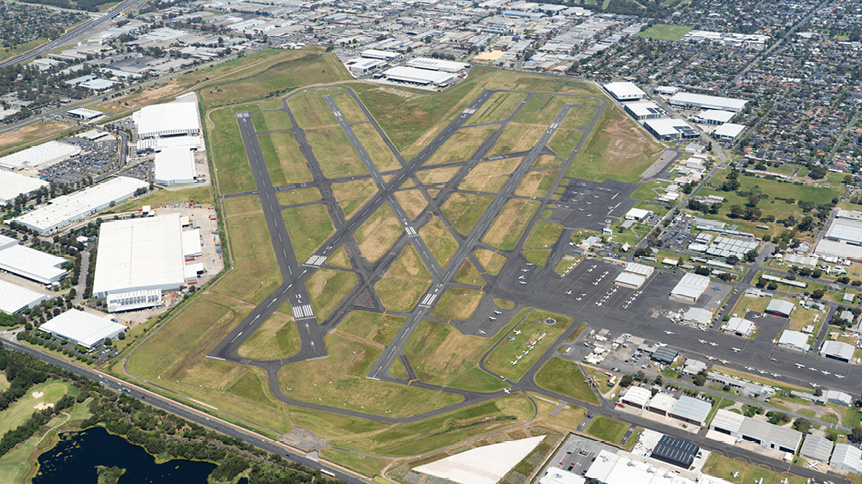Moorabbin has a complex runway and taxiway system.
Wingspan limitations apply to the aerodrome. Areas of the main apron and northern apron are marked advising where aircraft with wingspans 11.5 m or greater and 18 m or greater are not permitted. Pilots must exercise caution due to reduced wingtip clearances.
Circuits on RWY 35R/17L and 31R/13L are to the east on frequency 118.1. Circuits on RWY 35L/17R and 31L/13R are to the west on frequency 123.0.
Typically, one runway will be used for circuits while the other (parallel) runway will be primarily used for arrivals and departures. However, this is by no means always the case. Always follow ATC instructions and, if you are unsure of procedures, ask for help.
Key areas when planning to navigate around an aerodrome are:
- study the layout, paying particular attention to complex intersections and runway incursion hotspots in ERSA
- anticipate and plan your taxi route to and from the runway in use based on information from the ATIS, NOTAMs, ERSA, recent experience and the aerodrome chart
- have the aerodrome chart or diagram readily available to use during the planning phase and while taxiing
- check the route on which you are taxiing against the chart or ERSA and again, pay special attention to complex intersections
- continually scan for conflicting traffic and holding point markings
- confirm your assigned route if you are in doubt about the taxi instructions received from a controller.
A specific clearance is required to enter, backtrack, line-up on, cross, take-off from and land on a runway. When taxiing, ensure you have received a specific clearance to cross any runway on your taxi route. Whilst taxiing, do not turn your radio down to brief or chat, you may miss some key ATC instructions.
The clearance will include your callsign and the words ‘CROSS RWY XX’. An ATC clearance to line-up does not authorise the pilot to backtrack on the runway.
While taxiing, the use of standard operating procedures and your radio will increase the safety of operations. This includes following instructions from ATC, confirming your understanding of ATC instructions by ensuring correct readbacks, maintaining situational awareness, using all resources available and ensuring effective pilot/controller communication practices. At the holding point, ensure your ‘ready’ call is on the correct frequency.
Using non-standard radio calls or readbacks affects the ability of ATC to understand your intentions and confirm that you have understood your clearance.
The principle of good communication is to effectively articulate:
- who you are
- where you are
- what you want.
When landing, runway confusion can be avoided by:
- paying careful attention to runways in clearances
- always reading back an assigned runway in full
- taking sufficient time during the approach briefing to determine how positive runway identification will be achieved, particularly if using a non-precision, circling or visual approach
- visually identifying the correct runway before entering or landing on it, depending on weather conditions
- distinguishing between runway lighting and taxiway lighting, which are coloured differently.
Start approval is required for:
- circuit operations
- aircraft departing for aerial work in the Melbourne TMA (terminal area)
- aircraft landing at Melbourne Airport.
- aircraft departing above 2,000 ft for landing at Essendon.


